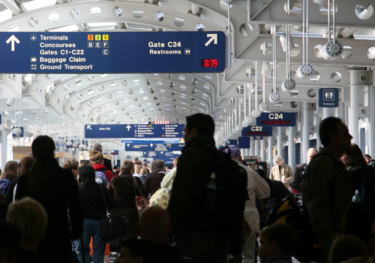Blog | 24 Jul 2024
Airport chaos, a software glitch, and the cost of downtime

Teri Robinson
Managing Editor, Thought Leadership

The tsunami of flight cancellations that followed July’s global tech outage made the costs of computer downtime painfully clear to thousands of stranded travellers. Multiply such failures across the world’s largest companies and the cost of downtime is some $400 billion, or nine per cent of profits at Global 2000 organisations, according to new research by Oxford Economics in partnership with Splunk.
Measuring the overall cost of downtime is difficult—costs are often hidden in corporate operations and interactions with partners and customers—and the impact can take many forms. This time, the culprit was a glitch in an update to a widely used software platform. The next time might be the result of a cybersecurity incident like 2017’s WannaCry debacle, or human error, infrastructure failure, even a geopolitical event. Airlines, financial institutions and healthcare organisations are the public face of the current disruption, but companies of all stripes are vulnerable to the kind of financial, operational and reputational damage that ensued.
When we completed our work with Splunk, including a survey of 2,000 executives from leading firms around the world, we had no way of knowing that the research would be brought to life so dramatically just weeks later. We did know that the study, The Hidden Costs of Downtime, included some stark numbers:
- $49 million – average lost revenue a company experiences annually
- 75 – the number of days it takes to recover that lost revenue
- $22 million – the average regulatory fines an organization racks up per year
- $16 million – missed SLA penalties a company accrues in a year
- 79 – number of days it takes to recover from a downtime incident

As organisations cede more control to technology partners and our digital interconnectedness expands faster than tech infrastructure can keep up, the likelihood of incidents with global impact grows. It is more crucial than ever, then, to safeguard whole ecosystems against problems caused by individual failures, because as businesses—and travellers—around the world are painfully aware, it only takes a single glitch in a widely distributed platform to put multitudes at risk. Minimising the impact of downtime depends on the organisation, but some guidance can be found from the resilience leaders identified in our downtime study. These companies recover faster from downtime incidents, are less likely to incur hidden costs, and rack up less revenue loss. Perhaps that is because they are investing more—an average of $12 million each, annually—in security tools and are ramping up their use of emerging technology like GenAI.
Downtime is a risk in any computing environment, but that risk does not have to lead to catastrophic failures–or costs.
Tags:
You may be interested in

Post
Measuring the Number of Jobs that benefit from US Businesses using TikTok
We have published a new report measuring the number of US jobs benefitted by TikTok. This builds upon a 2024 report which estimated the economic contribution of SMBs using TikTok Starting in November 2024, Oxford Economics carried out a study to estimate how many people working in US businesses using TikTok directly engaged with or indirectly benefited from the platform.
Find Out More
Post
Future of Global Growth: Deglobalisation
This infographic presents our Megatrends Scenarios model, which outlines various long-term global scenarios.
Find Out More
Post
The UK’s competitive advantage in green innovations
The UK can capitalise on growing opportunities in green innovations by investing in sectors where it has a competitive advantage. This study identifies the innovations for which the UK has the greatest potential to unlock economic growth.
Find Out More